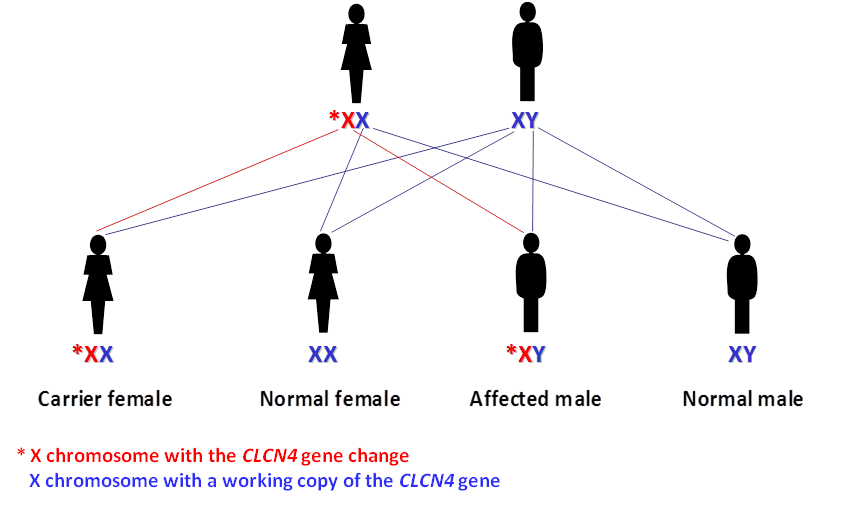General information
What is a CLCN4-related disorder?
CLCN4 related genetic disorders are caused by changes in the CLCN4 gene. The CLCN4 gene is located on the X chromosome and is thought to be important for brain development and function. Changes in the CLCN4 gene have been linked to learning and behavioural challenges and types of epilepsy. Only 16 families with changes in the CLCN4 gene are currently known around the world, so we are still learning more about this condition.
How do you test for a CLCN4-related disorder?
The testing can be arranged by a paediatrician or a geneticist and involves a blood or saliva collection. The DNA is tested for a genetic change in the CLNC4 gene.
How is a CLCN4-related disorder inherited?
An individual may have a new (‘de novo’) genetic change in the CLCN4 gene, which is a new genetic change for them, and not inherited from the family.
Alternatively an individual may inherit a CLCN4-related genetic change in an X linked manner. Males inherit an X chromosome from their mother and a Y chromosome from their father. Males who inherit an X chromosome with a CLCN4 gene change will have a CLCN4-related disorder. Females have two X chromosomes; one from their mother and one from their father and each X chromosome has a CLCN4 gene. Females who have a gene change in one of their CLCN4 genes are called carriers.
What are the health implications associated with being a carrier of a CLCN4 gene change?
Female carriers of an inherited CLCN4 gene change do not usually have intellectual disability or seizures. However, some female carriers may have mild learning or speech problems or an increased chance of mental health conditions (anxiety and/ or depression). We also know of one female with an inherited CLCN4 gene change who is severely affected: with a seizure disorder starting in infancy and severe intellectual disability. Conversely, if a female has a new genetic change in CLCN4, that is not present in either parent, they are more likely to be affected with intellectual disabilty and/or a seizure disorder.
What are the chances of a female carrier having a child with a CLCN4-related disorder?
When a female carrier is having children, for each pregnancy, there is a 50% chance of passing on the X chromosome with the working CLCN4 gene and a 50% chance of passing on the X chromosome with the CLCN4 gene change (see diagram below).

Female carriers have choices when planning children and these options can be discussed further with a clinical geneticist.
What are the chances of a male with a CLCN4-related disorder having a child with the same disorder?
Males pass on their X chromosome to all their daughters and a Y chromosome to their sons. Males with a CLCN4 related disorder would, if they have children, pass on the X chromosome with the CLCN4 gene change to all of their daughters. This means all their daughters will be carriers and at risk of having sons of their own with a CLCN4-related disorder, or of being affected. As a male with a CLCN4 disorder passes on his Y chromosome to all his sons they will not be carriers or have a CLCN4-related disorder.

For more information on CLCN4 related disorder and to get in contact with other families, you could visit: https://www.facebook.com/groups/272975780022928/
